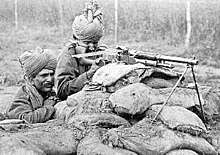Hotchkiss M1909 Benét–Mercié machine gun
| Hotchkiss M1909 Benét–Mercié machine gun | |
|---|---|
 A Hotchkiss Mark I. | |
| Type | Light machine gun |
| Place of origin | France |
| Service history | |
| Used by | See Users |
| Wars |
Border War World War I Russian Civil War Irish Civil War World War II |
| Production history | |
| Designer | Laurence Benét and Henri Mercié |
| Designed | 1901 |
| Manufacturer | Hotchkiss et Cie |
| Produced | 1909 |
| No. built | 40,000+ in GB; ~700 in USA |
| Variants |
Hotchkiss M1909 (French Army, 8×50mm Lebel) Hotchkiss Mark I (Britain, .303) Benét–Mercié Machine Rifle M1909 (United States, .30-06) |
| Specifications | |
| Weight | 12 kg (26.5 lb) |
| Length | 1.23 m (48 in)[1] |
| Barrel length | 64 cm (25 in)[1] |
|
| |
| Cartridge |
.303 British (Britain) 8mm Lebel (France) .30-06 Springfield (U.S.) 7×57 mm Mauser (Brazil and Spain) |
| Caliber |
.303 (7.70 mm) 8 mm .30 (7.62 mm) 7 mm |
| Action | Gas-operated |
| Rate of fire | 400-600 rounds per minute[1] |
| Maximum firing range | 3800 m |
| Feed system | 30-round feed strip, or belt-fed |
The Hotchkiss M1909 machine gun was a light machine gun of the early 20th century, developed and built by Hotchkiss et Cie. It was also known as the Hotchkiss Mark I, Hotchkiss Portative and M1909 Benét–Mercié. It was based on a design by a Viennese nobleman and Austrian Army officer, Adolf Odkolek von Újezd, who sold the manufacturing rights to Hotchkiss in 1893. Several improved versions were designed by Hotchkiss's American manager, Laurence Benét and his French assistant, Henri Mercié.
Design
It was gas-operated and air-cooled, had a maximum range of 3,800 m (4,200 yd) and weighed 12 kg (27 lb). Initial models were fed by a 30-round feed strip but later models could be either strip-fed or belt-fed. The U.S. types had a bipod, while some others used a small tripod. This tripod, fitted under the firearm, could be moved with the weapon, and was very different from larger tripods of the period.
Manufacture
Production began at the Hotchkiss factory in Saint-Denis, Paris, but in 1914, with the invading German army threatening the city, the French military authorities ordered the factory to be moved to Lyon. The following year, the British government invited Hotchkiss to set up a factory in Coventry. By the end of the war, this factory had manufactured over 40,000 M1909s.[2]
The U.S. version was made by Springfield Armory and by Colt's Manufacturing Company. Total production for the United States was 670.[1] This may seem small compared to the huge production runs of firearms later in the 20th century, but this was a significant number for the size of the contemporary U.S. Army. The M1909's adoption coincided with the withdrawal of the .30-06 manually operated Gatling guns from the U.S. Army's arsenals.
Service
As the Hotchkiss M1909 (or Mle 1909), firing the 8 mm Lebel, it was adopted by the French military in 1909 but not issued as an infantry weapon. The 700 examples manufactured were used in the fortresses at Verdun in a defensive capacity, on some fighter aircraft, and in Mark V* tanks acquired from Great Britain.
A variant to use the .303 round was produced in Britain at the Coventry factory as the "Hotchkiss Mark I". It was issued to some cavalry regiments, and the MkI* variant, with the wooden stock replaced with a pistol grip, was widely used in British tanks during World War I.[3]
It was adopted by the United States in 1909 as the "Benét–Mercié Machine Rifle, Caliber .30 U. S. Model of 1909" firing the .30-06 cartridge. It was also used by other countries, including Belgium, Spain, Brazil and Australia. France and Britain used the Hotchkiss M1909 through World War I and on into World War II. The Australian Light Horse, the New Zealand Mounted Rifles Brigade, the Imperial Camel Corps, and the Duke of Lancaster's Own Yeomanry[4] used the Hotchkiss in the Sinai and Palestine Campaign (1915–17).[5] U.S. forces used the Benét–Mercié at the Battle of Columbus in 1916 (4 guns fired 20,000 rounds total in the engagement), in the subsequent Pancho Villa Expedition in Mexico of 1916–17, and initially in France. Firing pins and extractors broke frequently on the American guns.
Some members of the U.S. press derisively called the M1909 the "daylight gun" because of the difficulty in replacing broken parts at night and jams caused when loading strips were accidentally inserted upside down in darkness.[1] However, Major Julian Hatcher was assigned to look into the issue after Columbus and found almost all the issues were due to inadequate training. U.S. troops during the Villa Expedition received additional training and the M1909 was considered an effective weapon.[6] It could have seen extensive use with the U.S. in World War I but production had already ceased and only a small number were available. The U.S. Navy still used them, however in that period.
Users
.svg.png)

.svg.png)



.svg.png)



.svg.png)
.svg.png)

.svg.png)
_crowned.svg.png)
Gallery

2nd Queen Victoria's Own Rajput Light Infantry gunners in Flanders, winter of 1914–1915  Old Glory postcard with U.S. soldiers firing an M1909 machine gun
Old Glory postcard with U.S. soldiers firing an M1909 machine gun Hotchkiss Mark I on display at the Steven F. Udvar-Hazy Center
Hotchkiss Mark I on display at the Steven F. Udvar-Hazy Center
See also
- Light machine gun
- List of individual weapons of the U.S. Armed Forces
- Huot automatic rifle
- Chauchat - Another French light machine gun that was also used by the U.S. Army
- Hotchkiss M1922 machine gun
References
- 1 2 3 4 5 Bruce N. Canfield "The Daylight Gun": U.S. Model of 1909 Benét–Mercié Machine Gun" American Rifleman September 2010 pp.84–87
- ↑ A Peripheral Weapon?: The Production and Employment of British Tanks in the First World War David J. Childs Greenwood Publishing Group, 1999 p87
- ↑ "Hotchkiss Machine Gun Mk 1*". IWM. Retrieved 27 November 2016.
- ↑ Bull, Stephen, 1998. World War One British Army. Brassey, London and Washington. p94
- ↑ Ion Idress: The Desert Column, Angus & Robertson 1944, p. 225
- ↑ Hatcher, Julian S. (1962), Hatcher's Notebook (3rd ed.), Harrisburg, PA: Stackpole Books, pp. 93–101, LCCN 62-12654
Further reading
- Robert G. Segel (3 January 2012) U.S. Automatic Machine Rifle Model of 1909, Small Arms Defense Journal, Vol. 2, No. 4
External links
| Wikimedia Commons has media related to Hotchkiss Mle 1909. |
- Images from the Museum of the Soldier, Portland, Indiana
- More images: 1, 2
- Complete Guide to the Hotchkiss Machine Gun origyear=1917
- http://www.forgottenweapons.com/light-machine-guns/hotchkiss-portative-lmg/
- Handbook of the Automatic Machine Rifle Caliber .30, Model of 1909. Ordnance Department. 31 July 1916. (many good plates)
- "New Machine Guns Ordered: Vickers Recoil Type Will Replace Those That Jammed". New York Times. 24 March 1916.
- Collection of photos that appear to be either U.S. Army photos or published before 1922
- http://img.photobucket.com/albums/v146/Ordnanceguy/US%20MGs/MGtroopSoldier.jpg
- http://img.photobucket.com/albums/v146/Ordnanceguy/US%20MGs/BenetMercierRPPC.jpg
- http://img.photobucket.com/albums/v146/Ordnanceguy/US%20MGs/MoreMGTroopsonBorder1914.jpg
- http://img.photobucket.com/albums/v146/Ordnanceguy/US%20MGs/MotorcycleMGTroop.jpg
- http://img.photobucket.com/albums/v146/Ordnanceguy/US%20MGs/M1909BMMGMotorcycleMountedRPPC.jpg
- http://img.photobucket.com/albums/v146/Ordnanceguy/US%20MGs/BenetMercierMGPlatoon27thInf19131.jpg
- http://img.photobucket.com/albums/v146/Ordnanceguy/US%20MGs/BenetMercieGroup.jpg